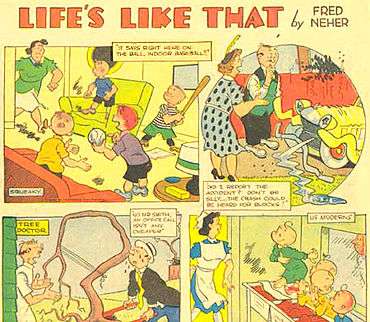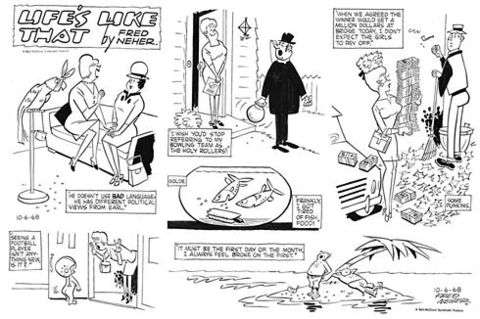Life's Like That

Life’s Like That was a gag panel by Fred Neher which found humor in life's foibles. Spanning five decades, the series was initially distributed by the Bell Syndicate and later by Consolidated News Features and the United Features Syndicate.
Neher had drawn a comic strip, Goofey Movies, for five years, plus sales of gag cartoons to 42 magazines, including Collier's and The New Yorker, when the Bell Syndicate signed him on in 1934. Life's Like That was launched October 1, 1934 and ran until 1941 but disappeared from newspapers during World War II. After the war, it returned for a run from 1945 to 1977, when Neher retired. He stopped doing the Sunday half-page in October 1972.[1]
At its peak, Life's Like That was published in 500 newspapers. The Sunday format gave several cartoons a free-floating grouping, with variations, including one arrangement similar to George Lichty's Grin and Bear It, displaying several square-shaped panels with one in a circle.[2][3]
Doug Sweet, of The Montreal Gazette, recalled that his newspaper ran Life's Like That when it carried no other syndicated gag panels or comic strips:
- Our comics have come a long way from December 15, 1937, when–to the best of our recollection–The Gazette began publishing its first regular cartoon. Life's Like That, drawn by Fred Neher (1903-2001), was a weekly, single-panel cartoon that sat at the bottom of the front page of the second section on Wednesdays. Soon after we added other strips, like Mickey Mouse. This newspaper was late getting into the comics business.[4]
When Neher died at age 98 in Boulder, Colorado in 2001, Owen S. Good wrote in the Rocky Mountain News:
- He is survived by pot-bellied businessmen, henpecked husbands, worldly-wise goldfish and babies with thin curlicues of hair, all actors in the everyday comedies he staged on the funny pages.[5]
Archives

During the 1950s and 1960s, Neher taught cartooning at the University of Colorado for 12 years, and he donated his Life's Like That cartoons to the University of Colorado Library Archives (where they fill 36 linear feet). As he described it, "Univ. of Colo. ask to have all my original drawings for safe keeping... came in a truck and left me only my shorts."[6][2]
References
- ↑ Morehead, Toni. "The Nappanee Six".
- 1 2 National Cartoonists Society
- ↑ Michael Maslin: The New Yorker Cartoonists, A-Z
- ↑ Sweet, Doug. "New comic strips getting a test spin", The Montreal Gazette, December 31, 2005.
- ↑ Rocky Mountain News, September 26, 2001.
- ↑ University of Colorado: "A Guide to Manuscript Collections"